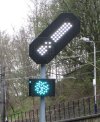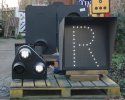I think that's the VMS type. The Signal House and Dorman (I believe) types, effectively replaced the halogen light source with a LED one, but kept the fibre optic bundle. I suspect that's partly because it makes ensuring an unambiguous indication simpler
The drive from the interlocking will always be fail safe. Proving, where provided by the interlocking, will also be fail safe.
The possible failure mode(s) may vary according to the method of construction-
Dorman type - each LED is used only once, this means there is a limitation on how many indications can be shown in a single box, as there is with (others) fibre-optic type before them, because each fibre end takes up a position on the matrix plate at the front, like an individual LED.
For a Standard LED indicator (ie a large one replacing a traditional 'theatre'), I believe the limit is 6 indications. For the Miniature indicator, replacing a 'Stencil', I think it's 4, but it varies depending on how many characters each indication has - eg 2 x 3 char, 3 x 2chr.
I'm not aware of Dorman ever having made fibre optic indicators.
Signal House make fibre optic indicators, I believe they are the only manufacturer to do so now. Originally they used a 55W halogen lamp but now offer an LED alternative (but still with fibre bundles).
VMS (now Mallatite) - original LED indicators were similar in principle to Dorman I think, ie chains of LEDs specific to each indication - but some years ago they introduced a 'Mk 2', which provides for up to 20 indications in a Standard. The only way I can see this working (ie physically fitting in the case), is that the LEDs are used in multiple indications, much as the lamps were in the old 7x7 Multi-lamp Route Indicators (Theatres). Whereas the logic for an MLRI was done with relays in the location case or relay room, I suspect the Mk 2 has some internal electronic or processor-based logic to sort out which LEDs to light from a given (single) input, so that would presumably need to have an appropriate SIL rating in order for the indicator, as a unit, to be considered 'fail safe'


